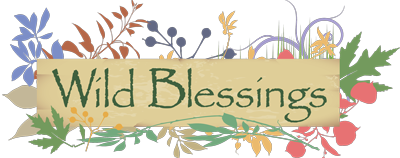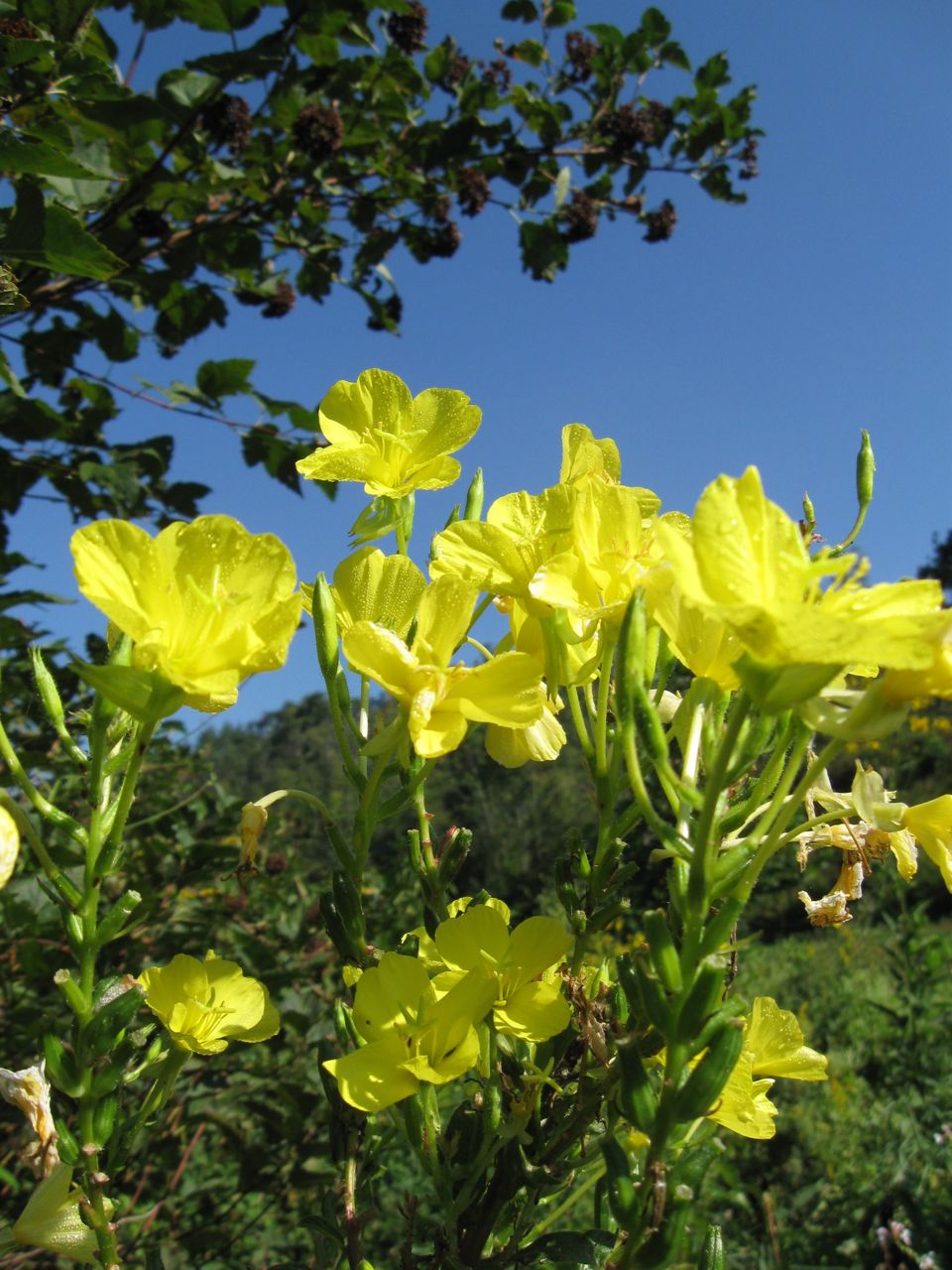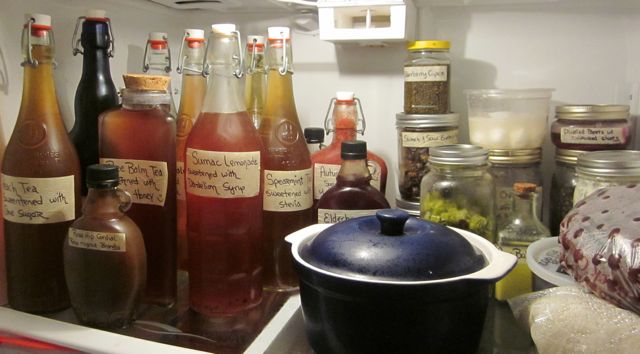 It occurred to me today as I was cleaning out my refrigerators (I have two of them), that they are filled with rather odd contents. Just for fun I decided to record a list of what wild goodies I have in stock.
It occurred to me today as I was cleaning out my refrigerators (I have two of them), that they are filled with rather odd contents. Just for fun I decided to record a list of what wild goodies I have in stock.
My WILD refrigerator contents list:
Pickled and fermented jars: pickled beets with Milkweed shoots, sweet and sour Burdock root, Nettle and Milkweed sauerkraut, Pickled Milkweed flower buds, Gingered carrots with Milkweed pods, Milkweed shoot kimchi, Japanese sauerkraut with Nettle, Japanese Knotweed pickles, Purslane Pickles, pickled Cattail Shoots, Elderberry capers
I’m really into fermenting using whey from wonderful RAW milk from happy grass fed loved-on cows. You can check out my blog about that here: https://wildblessings.com/?s=my+fermenting+frenzy
Wild syrups: Wild cherry syrup, Autumn Olive Berry syrup, Elderberry syrup, Dandelion syrup, Sumac syrup, Pomegranete syrup, Peach syrup, MAPLE syrup boiled down from my trees
Wild Jams: Knotweed berry jam, Wild grape jam, Elderberry jam, Violet flower jam, Purslane Chutney, Blackberry jam, Blueberry jam
Wild oils: Bee Balm oil, Evening Primrose oil, Dandelion oil, Oregano oil, Mullein flower oil…
Bone broths: made with many wild roots (burdock, Dandelion, Evening Primrose, Queen Anne’s root, Astragulus) and wild leaves the secret ingredient to my bone broth (besides the wild ingredients) are the chicken feet. I clip their nails before tossing them in the pot. The key to a great soup is great stock. I take delight in making mine as healthful and wildly tasty as possible.
Freezer list:
Milkweed (shoots, buds, pods), Knotweed rings (they look like calamari!), Cattail shoots (taste like cucumbers!), Cattail cobs, Blackberries, Autumn Olive Berries, Elderberries, Deer meat…
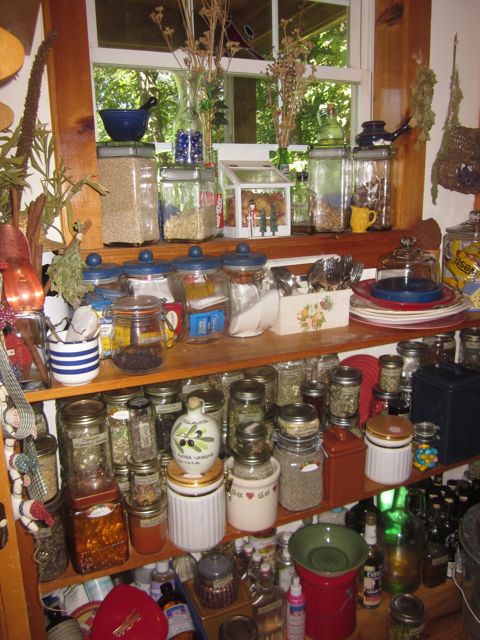
My pantry is a bit odd as well: Amaranth seeds, dried Elderberries, Hawthorn berries, Mullein leaf and root, Rose Hips and Petals, Lavender flowers, Blackberry and Raspberry leaves, Yellowdock seeds, Dandelion Leaves and Roots, Red Clover flowers, Lambsquarter seeds and leaves, Burdock roots, Evening Primrose roots, Joe Pye weed roots, Thistle buds, ……. all these and much more line my shelves waiting to be used reconstituted in soups and stews, or floured to add nutritious boosts to my breads, or made into healing teas and decoctions.
Drying tips
It is very important how you dry wild plants. First, it is best to harvest in the morning after the sun has burned off the early dew but before the day is too hot. If you are a really organized person you can bundle them as you harvest. I prefer the rubber band method. These bundles are then carefully placed in your foraging basket (grocery cart). It would be so easy to do it that way. I’ve only ever done that once or twice, usually I toss my days catch in a basket and when I get home dump the contents on my kitchen counter where I garble and sort them into piles. Garbling is removing bugs, bug bites, dead leaves….quality control.
Here is a photo of my August 23rd shopping spree all garbled and ready to hang to dry or just eat for lunch.
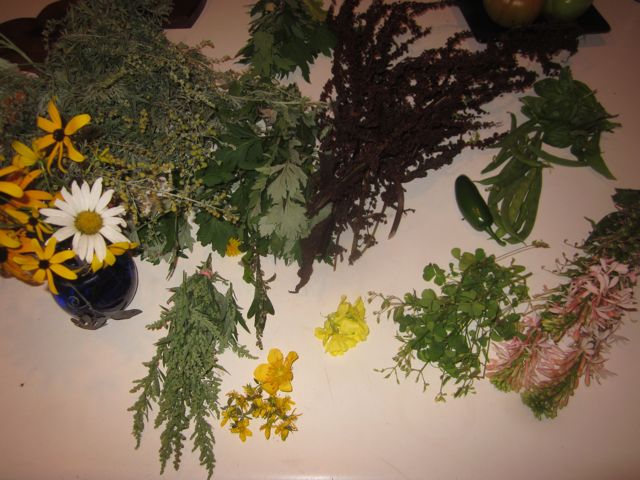
The Wormwood (Artemisia) I am drying to use as a wooden floor cleanser (works great and smells good), the Mugwort I’m drying to make dream pillows with, the Yellowdock (Rubus crispus) seeds I’m collecting for winter stores and to make Yellowdock crackers for my upcoming wild foods dinner, the Lambs Quarter (Chenopodium album) seeds I am collecting to dry for making nutritious granola and hot cereal (gruel) or to put in my Sea Zest blend, the Sorrel (Oxalis) I am using for a soup for my lunch, the few piddly flowers Evening Primrose (Oenothera biensis) and Saint John’s Wort (Hypericum perforatum) I am adding to their respective jars of oil to infuse for a plethora of delightful reasons, the Cardinal Flower is medicinal but I can’t remember what for (I’ll study it this winter when I have time!), greenbeans from my teepee pole, some basil and a jalapeno pepper are the only cultivated plants I harvested from today and I am just as thankful for the weeds as I am these grown gifts. Oh and I always pick flowers for setting a nice table.
Here is a photo after a shopping spree where I dug Fall Burdock roots and harvested Amaranth (the highest plant in nutrition there is)
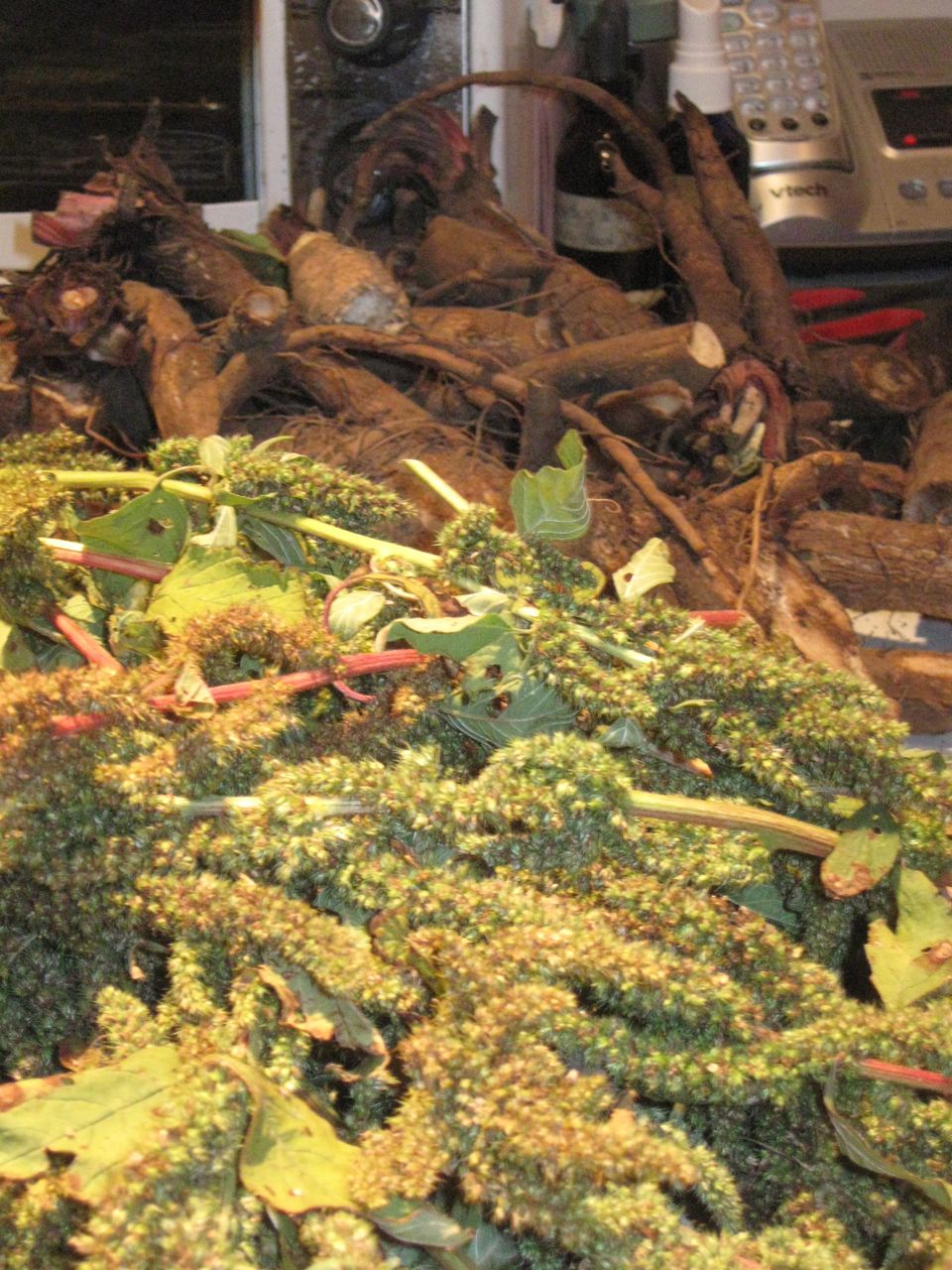
More on drying
The spot where you hang your ‘catch’ to dry must be dry and out of direct sunlight. I have pounded nails in the wooden ribs of my attic eaves and from this hang bunches of fresh herbs to dry. The bundles should never be too large for the purpose of thorough drying.
I also pounded nails in old tobacco hanging rods and perch these on door frames in my hallway. Our ceilings are tall and the herbs that I hang from these nails are still above our heads. It looks really cool and depending what is hanging there to dry, the scents are delicious. Spearmint, Lemongrass, Lavender and Peppermint is especially overpowering in it’s aroma therapy! Some of my younger friends think my home looks like a set from the Harry Potter movie!
I also consider the moon cycles to harvest wisely. The best time to harvest in order to increase yield is in the first two quarters of a new moon. This is because the moon is pulling hard on the earth and all it’s life from the ocean tides to our physiological cycles during these phases. If you want to tame a particularly out of control weed, harvest it in the 3rd or 4th quarter of the moon’s cycle. I follow this rule of thumb in mowing the yard as well. Mow it in the first quarter and it will be ready to mow in a few days, mow it in the second half (particularly the 4th quarter) and it will grow back MUCH more slowly.
Once dry the next step is to destem the herbs. This is a fun thing to do when you have a friend over for a visit. It is a bit tedious but not requiring much brain power so you can talk and enjoy your company while desteming your fragrant intriguing dried wild foods.

Tips for Destemming
Hold the plant upside down and pull the leaves off with a closed hand as you go down the stem. This doesn’t work on all plants (like Motherwort for example!).
Keep the dried stems as fire starter material or as smudge sticks. It is a delightful way to bring Summer into a Winter fireplace scene when the smell of Spearmint or Peppermint from the kindling sticks explode into your olfactories.
I forgot to mention when you were bundling herbs to dry, it may be helpful to label them so you know what you are destemming. It is often hard to recognize a plant once it has shriveled into a dry state. I never bother with that cause I like to trust my sense of smell and taste and I’ve been at this for a long time. Still there are mystery plants that I get stumped by but that makes it all the more fun:).
Storing
Now that your plants are dried perfectly it is time to store them in glass (preferably). They will keep in this state for years and years. Linda Runyon claims that her dried wild edibles that she has jarred from 30 years ago are still viable (albeit minus some chlorophyll). As a rule of thumb, I keep my dried plants that I use for medicinal purposes for a year and then relocated them to ‘food’ or to the compost bin.
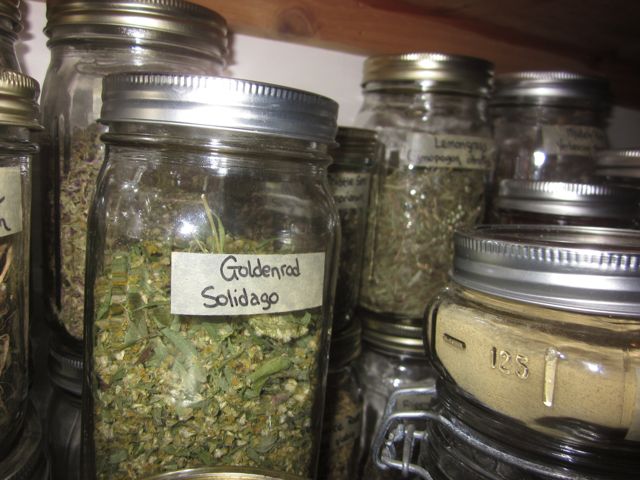
Since I dry WAY more than a quart sized jar of each plant, I store the rest in large paper bags (labeled) and then stored in either trash bags (plastic) or in a storage bin. My goal would be to one day have gallon sized or larger glass bottles to keep them all safely in but that is just a goal.
Recording
Herbs whether dried, oiled, vinegared, tinctured or canned have a way of multiplying like rabbits. To me, the more the merrier, but after awhile it does get kind of confusing. What DO I have anyway? So keep a ledger, a daily log of what you shopped for, and what you did with it. The only way to keep track of this is just to do it. Then you know what you have in stock.
Hope this was helpful.
We are indeed WILDLY blessed!
Holly
Psalms 145:15, 16 “The eyes of all look to You, and You give them their food in due time. You open Your hand and satisfy the desire of every living thing.”
